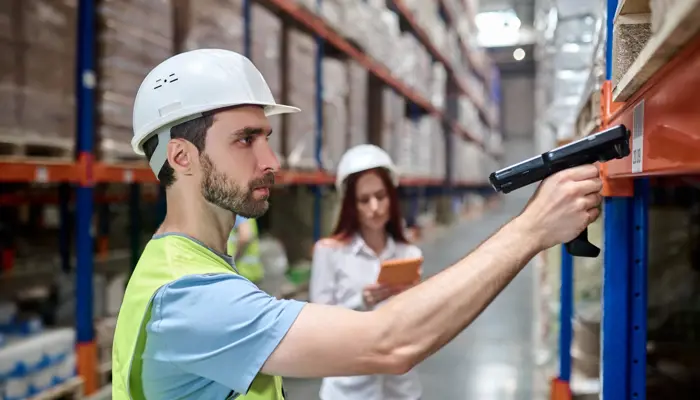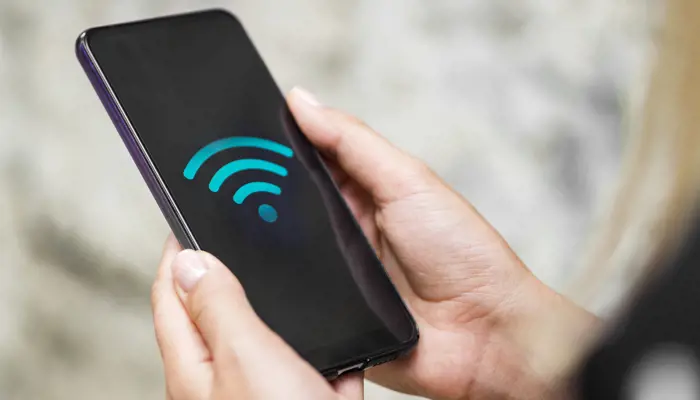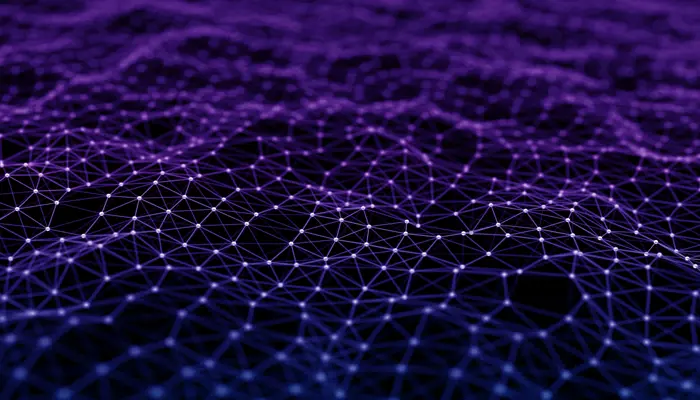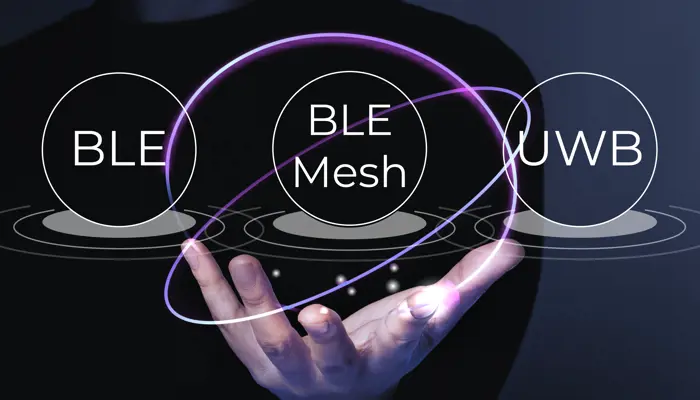
Localisation through BLE: what is it and how does it work?
Localisation via Bluetooth Low Energy (BLE), together with ThinkIN software, allows you to track the location of objects and people, and create a digital twin of physical environments, with important spin-offs in terms of efficiency and process monitoring. Find out why you should be interested in integrating this technology into your business.
- BLE is reliable, energy efficient and present in many IoT devices
- Localisation via BLE is extremely flexible, scalable, with accuracy ranging from 5 metres to 50 cm
- Real-time location systems using BLE together with ThinkIN software provide location data to achieve high levels of efficiency and performance of business processes.
First introduced in 2010, Bluetooth Low Energy (BLE) is gaining in importance, transforming the future of communication and connectivity. Nowadays, we all know it for its ability to wirelessly connect everyday devices, such as our headphones. However, it is also widely used as a localisation technology with a variable accuracy that, depending on the technique used, can be below one metre. Localisation via BLE, together with ThinkIN software, makes it possible to track the position of objects and people, and to create a digital twin of environments, with important spin-offs in terms of efficiency and process monitoring.
In the following article you will learn what BLE is exactly, how it can be used for localising objects and people and, more importantly, why you should be interested in integrating this technology into your business.
What is BLE?
BLE is an intelligent version of Bluetooth technology, created to operate at extremely low energy levels. First known as support for communication between device networks, it is now frequently used as a device positioning technology, in line with the market trend of a growing need for indoor geo-localised services in various industries.
BLE is characterised by a number of factors that make it a unique technology to be implemented in your facility. BLE is designed to minimise power consumption, consequently, the batteries of BLE devices have a long lifespan, operating for up to 2-4 years. Furthermore, BLE is a very versatile technology that can integrate with different types of devices. Finally, it is supported by a very robust signal even in complex working environments, such as industrial plants or healthcare facilities. This makes it a valuable and reliable technology able to ensure correct data transmission.
RTLS through BLE: how does it work?
Real Time Locating Systems (RTLS) based on BLE technology are localisation systems used to locate objects moving within a physical space and are typically based on the following devices and components:
Tags: tags are small devices used to locate resources or people within an indoor space and are attached to the resources or people to be tracked. For this reason, they can be of various shapes depending on what is being tracked, e.g. rectangular, round or in the form of a bracelet if it is to be worn by a person. Tags emit a BLE signal that is received by antennas.
Antenna: receiving antennas are devices anchored to the walls or ceilings of the monitored space. They are installed following a precise installation plan that varies according to the technology used and the performance required (e.g. the desired tag location accuracy). The antennas are powered and connected via a local network to the server where the localisation software is located. Depending on the technology and hardware used, the connection can be via Ethernet or WiFi. The antennas receive the BLE signal sent by the tags, depending on the technology they pre-process it and finally send it to the localisation software.
Tracking software: The tracking software receives the signal sent by the antennas and, using different techniques that vary depending on the technology used, estimates the location of the tag. The localisation software can be installed either on an edge server in the monitored environment or in the cloud. The position of tags calculated by the localisation software is then forwarded to applications, such as the ThinkIN platform, that use it to deliver services that vary depending on the industry.
There are several techniques for localisation via BLE, each characterised by different precision and infrastructural support. Among the most widely used are:
Received Signal Strength Indicator (RSSI): with this technique, the power received by the antennas of the BLE signal is used to determine the distance between the tag, which emitted the signal, and the antennas themselves. From the position of the antennas, the approximate position of the device can be calculated using trilateration algorithms.
The main features of this localisation technique are:
- the antennas are very simple from a hardware point of view and only need to be able to detect the strength of the received signal;
- at least 3 antennas are needed to be able to estimate the position of the tag. In the absence of 3 antennas, the position of the tag is approximated to that of the antenna that received the signal with the highest power.
- The higher the antenna density, the better the location. However, due to the reflection effects of the signal transmitted by the tag, localisation accuracy can hardly exceed 3 metres.
Angle of Arrival (AoA): this technique uses the angle of arrival of the signal transmitted by the tags on the receiving antennae. By being able to detect the angle of origin of the signal in three dimensions, this technique makes it possible to identify with a high degree of precision the position of the device that emitted it.
The main features of this technology are:
- the antennas require special hardware (as well as the necessary firmware), i.e. an array of antennas that can detect not only the power but also the direction of arrival of the signal;
- one antenna is sufficient to locate a tag. Each antenna is capable of covering the cone below, and consequently, the higher the installation height, the greater the coverage. Extended coverage can be achieved by adding antennas.
- By exploiting the angle of arrival of the signal, this technique offers greater robustness to reflections, resulting in a much more precise localisation that can reach up to half a metre in even complex environments.
BLE-based RTLS: benefits and use cases
The main advantages of localisation via BLE technology can be summarised as follows:
- an extensive ecosystem of vendors and manufacturers due to the popularity gained by Bluetooth over the years (not necessarily related to localisation). This means that there is an extensive number of hardware devices, especially tags, differing in form factors and characteristics.
- Low cost of tags and antennas: this makes this technology ideal in the case of having to localise a large number of assets.
- flexibility: BLE-based RTLS technologies are typically very flexible in terms of integration (e.g. with other existing IT technologies), deployment plan and accuracy. This makes it easy to adapt to the requirements of existing projects.
Leveraging these strengths, location systems using BLE provide the location of assets with sub-metre accuracy and can be implemented in various industries, such as manufacturing plants or healthcare facilities, as well as in retail settings. Indeed, thanks to BLE technology, together with the right software, you can create a digital twin of your shop, manufacturing plant or healthcare facility: through asset tracking, location services provide real-time visibility and control over business processes, but not only. Here are some use cases:
Industry
- Asset tracking
- Collision avoidance
- Process monitoring
- Access control
- Tooling management
- Warehouse management
Healthcare
- Asset tracking of medical equipment
- Automatic management of inventory
- Planning of maintenance activities
- Workflow digitisation and optimisation
- Monitoring patient safety
Retail
- In-store customer journey mapping
- Integration of POS data with the in-store customer journey
- Real-time queue monitoring
- In-store marketing services




